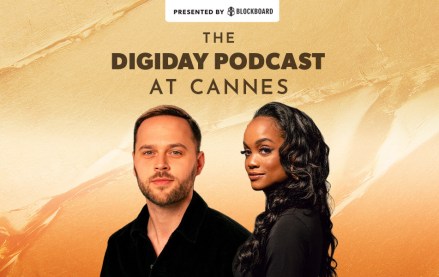How Fandom’s first-party data, FanDNA, is expanding to improve recommendations for advertisers and audiences

Subscribe: Apple Podcasts • Spotify
Wikipedia for all things fictional, fantasy and entertaining, Fandom has unique insight into how passionate internet users are about different shows, movies and video games. But the data doesn’t stop at the behavioral data around those curiosities. Fandom’s plethora of user generated content and community boards have also lended itself to the company’s first-party data collection.
And after 18 years of accumulating data on favorite characters, plot lines and cross-over interests, that first-party data, called FanDNA, is sold to advertisers to inform everything from traditional ad campaigns to research & development on new projects and merchandise.
On the latest episode of the Digiday Podcast, Stephanie Fried, CMO of Fandom, discussed how her team started categorizing this data into four, affinity-based groups to help clients understand where to invest and how to best reach their target audiences.
She also covered why Fandom is interested in developing the top-of-funnel, discovery side of its business. This year, the company acquired seven brands from Red Ventures, including TV Guide, to start building out data around how audiences find new programming, and is also building a new personalization tool to help recommend content and ads based on previous searches.
Highlights from the conversation have been lightly edited and condensed for clarity.
First-party data that rivals streamers
We call our data FanDNA and that’s really based on behavioral data of what people are doing on the platform and seeing that at scale across trillions of data points. The key reason that I came to Fandom was because I felt like there was so much insight that could be gleaned out of the data, and so many ways that we could use that information to create better fan experiences.
We have so much content. We have 45 million pages of content, and each of those pages is unlimited-scroll deep. And you compare it to something like a Netflix — remember for years, Netflix has been celebrated as having so much data. They know you, they know what to recommend to you when you go to your homepage on the Netflix screen, they know what you’ve watched on Netflix. They know what shows you’ve completed, what shows you haven’t and they also know where you dropped off, they know where you paused. But they don’t know what characters you love, and in what order. They don’t know what weapons resonate with you. They don’t know what specific details of the storyline you’re hovering over or diving into most deeply. And they don’t see the connections or shows outside of their ecosystem. So they don’t know what Hulu shows you love and characters you love. And they don’t know what games you love and what you’re playing.
I think what’s really unique about Fandom is that we see so much detail about what specifically are interested in, within each IP. And then we see the connections between the IP as well, which enables us to do a lot of really interesting things with the data.
Deeper than the ‘super fan’
One of the things we used to say [was] we’ve got the super fans, and at the end of the day, actually, when we looked at our fan base, certainly we have quote-unquote super fans, however you define those. But we also have pretty big fans, and then we have average fans, and then we have casual fans. And we’re thinking a lot about the broad spectrum of how people interact or engage with different IPs.
We uncovered four different identity segments. The advocate is [the] IP is part of who they are, it’s part of how they would introduce themselves. And it’s deep into their life. They might have a tattoo or a pet that’s named after that IP, because they want it to be part of their life every single day. Then there’s the intentionalist — someone who really likes specific categories [or a] genre that they lean into. They’re interested in the awards, they’re interested in reviews. The culturalist just wants to have like watercooler conversation, so they have FOMO of everything. They don’t want to miss out on things that people are talking about at dinner, they want to be able to have a point of view and they want to watch it just so they can have those almost like sound bites or opinions. And then finally, there’s the flirt, and the flirt is really just a fan of entertainment. They’re probably what we would call more casual viewers.
A case study in trending TV
We looked into those deeper fan identities or fan profiles to understand the composition of Fandom, because in this day and age and there’s so much to watch, and so much to play, it’s certainly challenging for advertisers and brands to break through. Getting a better understanding for their fans and their potential fans can help them understand their market development strategy and their marketing strategy and how they drive awareness and retention.
[For example,] ‘Sex Lives of College Girls’ over indexes on advocates and intentionalists – so there’s people who feel really close to ‘Sex Lives of College Girls’ and they’re really intentional about watching it and what that means as HBO is thinking about their campaign and the new season, it’s thinking about how do they then tap into those people who are already obsessed with the program, because a lot of other potential advocates and interventionalists also hear about things from friends and family like through their networks through people who are really passionate about it. And so a strategy of actually connecting with those [friends and family] influencers, as opposed to a big broadcast ad campaign. It might actually be more effective, doing unique experiences, tapping into that fan identity.
More in Podcasts

How TikTok’s ‘The Secret Lives of Mormon Wives’ landed on Hulu, with Select Management Group’s Danielle Pistotnik
The talent manager and executive producer of “The Secret Lives of Mormon Wives” joined the Digiday Podcast to break down the process of the reality show finding a home on Hulu.

Digiday Podcast at Cannes: Former Bachelorette Rachel Lindsay makes the case for creators
Between panels and parties, creators are looking to get face time with ad execs, brand marketers and partners like Spotify. However, rather than coming to the Croisette to strike deals, they’re playing a long game.

Digiday Podcast at Cannes: From center stage to closed doors, inside X’s quiet Cannes strategy
Once a Cannes hotspot, Twitter Beach is no more. In this episode, we explore X’s quiet retreat from the Croisette—and why no one’s talking about the TikTok ban either.








